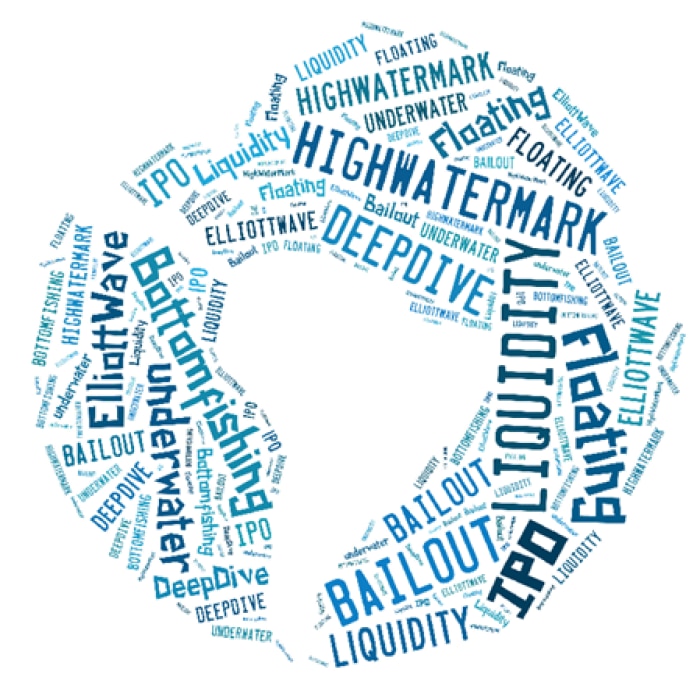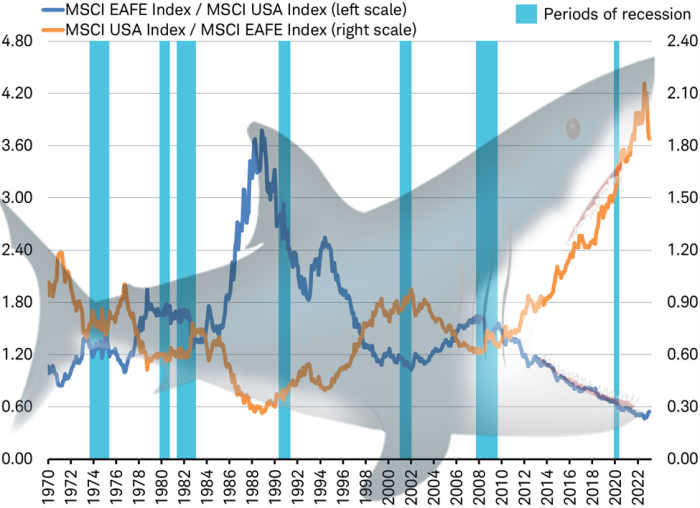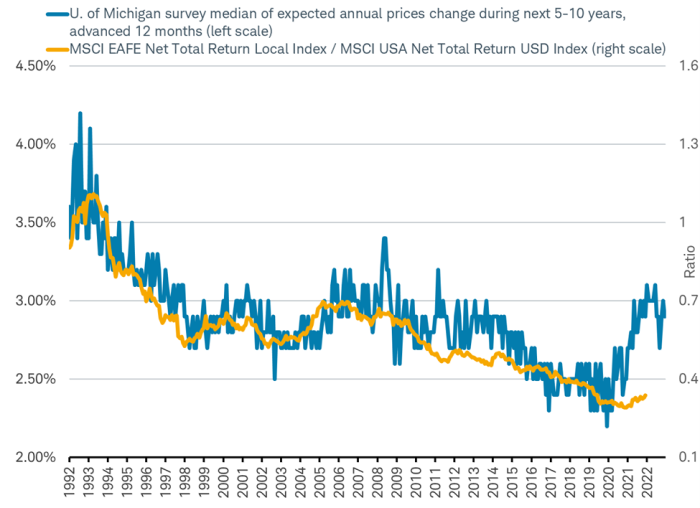Go With the Flow

The ocean connects all the world's continents and its people. In fact, three-quarters of the world's cities are along the coastline and 80% of the world's population live within 60 miles of the coast, according to the United Nations. More than 90% of the trade between countries is carried by ships while about half of the communications between nations use undersea cables.
We are all connected by the ocean and it's part of how we perceive the world. This extends into how we see the financial world and markets. We often use words that are connected to the vast oceans of water, such as:
- The liquidity of an investment
- Floating an IPO
- A bailout of a sinking company
- High-water mark for performance
- Bottom-fishing for ideas
- A deep dive in analysis
- Being underwater on an investment
- Elliott Wave analysis for technicians

Source: Charles Schwab
The oceans are filled with resources and opportunities, but they also hold risks—like sharks. A shark attack may be taking place right now on the portfolios of unwary investors.
Shark attack
International stocks, as measured by the MSCI EAFE Index, outperformed U.S. stocks, measured by the MSCI USA index, in 2022. The outperformance came despite the rise in the U.S. dollar, which eroded international gains in portfolios based in U.S. dollars. Measured in local currency, the outperformance was double-digit and the widest since 2005. The leadership by international stocks has continued in the first two weeks of 2023. A year ago, we had predicted 2022 could be the first year of international outperformance in a decade. Recessions and bear markets, followed by recoveries, happen at the turning points of every cycle. Each recession reverses the relative performance of U.S. and international stocks, as you can see in the shark chart below. While an official recession hasn't been declared yet, we believe a recession and bear market began during 2022.
Jaws closing

Source: Charles Schwab, Bloomberg data as of 1/12/2023.
Past performance is no guarantee of future results.
We have been using this shark chart for a long time to talk about cycles in investing and the danger posed when the trend changes and the jaws begin to bite down. Historically, each economic cycle the lines have changed direction; the leader becomes the laggard. The leaders of the last cycle tend to reverse and fall the most in the bear market while the recovery and next cycle tend to see new leaders. When the blue line is rising, international stocks are outperforming, as they did in the 1980s and 2000s, and when the orange line is rising U.S. stocks are outperforming as they did in the 1990s and 2010s. It reverses every cycle, but the degree of outperformance differs. The reasons are as behavioral as much as they are fundamental, after a full cycle of outperformance trends reverts. The only exception was in 2020. That recession was too short (at just two months) and saw too much stimulus from the U.S. Federal Reserve and the government as they pumped money into the economy and markets, further driving liquidity-driven U.S. tech stocks. But that stimulus reversed in 2022 for the first time in a decade, as did the relative performance, with international stocks leading the recovery.
Many investors are focusing on trying to determine if the bear market is over—but they could be missing the shift in leadership that may have already begun. A major shark attack is underway that could take a big bite out of unprepared investors' portfolios. Those who haven't rebalanced—trimming what had been outperforming and buying what had been lagging—could be especially at risk. These cycles tend to last years, not months, with the new leadership continuing until the next cycle. Therefore, even after a year of outperformance it isn't too late to rebalance from U.S. to international stocks to weights in line with a long-term strategic asset allocation.
Near-term drivers
Beyond the start of a new long-term economic cycle pointing to a likely shift to international leadership, there are near-term drivers that may help to sustain international outperformance in 2023.
- The mildest winter on record, as reported by the EU's Copernicus Climate Change Service (C3S), has limited the drawdown of natural gas to such an extent that Europe's gas reserves are now at their fullest for this time of year since at least 2016. As a result, gas prices are down -80% from their August peak, and the worst-case scenarios of energy shortages stemming from the war in Ukraine can likely now be excluded.
- Cheaper-than-expected energy prices have supported economic activity and employment while leading to a fall in headline inflation globally that has reinforced hopes of a coming halt to rate hikes.
- China's sudden reopening may lead to an economic rebound that could boost demand for Europe's exports, supporting industrial production this year.
- Earnings growth has been stronger outside the United States and is expected by analysts to remain so in 2023. The year-over-year growth earnings growth for S&P 500 companies in the fourth quarter is expected by the analysts' consensus to be -2.2%, compared to +14.4% for companies in Europe's STOXX 600 Index.
- International stocks tend to possess more of the characteristics, like high dividend yields and lower price-to-cashflow ratios, that have contributed to outperformance within and across sectors and countries over the past year. Combined with lower valuations, this has helped international stocks outperform, which may become more pronounced with the pause or reversal in the sharp rise of the dollar that characterized much of 2022.
- Consumers' long-term inflation expectations have risen back to 3%, after falling during the last cycle. As you can see in the chart below, rising inflation expectations in the U.S. (rising blue line) has historically tended to lead to international stock market outperformance (a rising orange line), with a lag of 12 months as investors price in the inflation outlook into relative earnings and valuations.
Inflation and international stocks

Source: Charles Schwab, FactSet data as of 1/17/2023.
Past performance is no guarantee of future results.
Risks
The cycles that have defined the relative performance of U.S. and international stocks for decades appear to be repeating and near-term drivers support this shift in leadership in 2023. But there can be no guarantees. We see two key risks to international outperformance in 2023:
- The ECB remains on a tightening trajectory. Although headline inflation has eased, underlying core inflation continues to trend higher. With the eurozone's unemployment rate at a record low in November, policymakers remain concerned about accelerating wage growth and are insisting they will not loosen their stance any time soon. This will compound the lagged effect on liquidity of the tightening that has already taken place, pointing to a significant deterioration of eurozone liquidity conditions over the coming months.
- The U.S. Federal Reserve could surprise with an about-face and begin to cut rates in 2023 and return to the cycle backdrop that powered liquidity-driven U.S. tech stocks to lead during the last cycle.
What to do
The global economy and markets are like the world's oceans; constantly in motion, teeming with different organisms interacting with each other.
Waves and changing tides are fun to watch but they prompt only short-term moves in water, like the waves of volatility in the markets or the changes in news flow that can drive them. In contrast, almost invisible, currents move water slowly but travel vast distances over a long-term cycle. While many investors watch the news flow and daily market swings, we foresee that the long-term economic cycle is likely to result in enduring and sizeable shifts in the markets favoring international stocks.
After a decade of leadership by U.S. tech stocks, rather than concentrating in a particular sector or country, a broadly diversified portfolio with exposure to international stocks may reward investors who go with the flow in 2023.
Michelle Gibley, CFA®, Director of International Research, and Heather O'Leary, Senior Global Investment Research Analyst, contributed to this report.